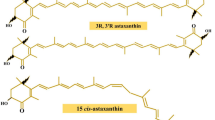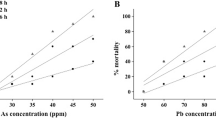Abstract
Nanomaterials are used in many fields, resulting in inevitably releasing into the aquatic environment. The presence of nanomaterials, including TiO2-GO in the aquatic environment, can be toxic to aquatic organisms. However, few studies have focused on the effects of TiO2-GO composite nanoparticle on crustaceans. In the present study, the giant river prawn Macrobrachium rosenbergii juveniles were exposed to two concentrations of TiO2-GO composite nanoparticle (0.1 and 0.5 mg/L). The effects of TiO2-GO composite exposure on activities of digestive and antioxidant-related enzymes and expressions of growth and immune-related genes at the transcriptome were studied. The results showed that the survival rate and growth performance were not negatively affected by TiO2-GO composite at the two exposure levels. Nevertheless, exposure to TiO2-GO composite causes an effect on the activities of digestive and antioxidant enzymes in the juvenile prawns. The enzyme activities of CAT, SOD, GSH-Px, AMS, TPS, and LPS in the 0.1 mg/L TiO2-GO composite experimental group were markedly reduced than those in the control group. Additionally, the expression level of genes involved in growth and immunity was significantly affected by TiO2-GO composite. After exposure to the 0.1 mg/L TiO2-GO composite, the mRNA expression level of MSTN was significantly increased, but the level of EcR, Raptor, and CaBP was significantly decreased. However, the mRNA levels of the CTL, TLR, JAK, and STAT were significantly increased after exposure to the 0.5 mg/L concentration of TiO2-GO composite. Furthermore, to understand the molecular mechanism of M. rosenbergii under TiO2-GO composite exposure, RNA-Seq was employed to analyze the changes of the muscle and hepatopancreas transcriptome. Compared with the control group, we identified 5166 and 4784 differentially expressed genes (DEGs) in the muscle and hepatopancreas, respectively (p < 0.05). Based on gene ontology and KEGG analysis, significant differences were observed in the DEGs involved in activity and binding, metabolism, immune response, and environmental information processing. These results showed that exposure to TiO2-GO composite nanoparticle led to the changes of enzyme activity and gene expression, suggesting that TiO2-GO composite existing in aquatic environments would disrupt the physiology of M. rosenbergii. This study will serve as a foundation for subsequent research into the evaluation of nanomaterial toxicity on crustacean species.







Similar content being viewed by others
Data Availability
The datasets generated during and analyzed during the current study are available from the corresponding author on reasonable request.
References
Barmo C et al (2013) In vivo effects of n-TiO 2 on digestive gland and immune function of the marine bivalve Mytilus galloprovincialis. Aquat Toxicol 132–133
Bettencourt A et al (2020) Analysis of the Characteristics and Cytotoxicity of Titanium Dioxide Nanomaterials Following Simulated In Vitro Digestion. NANOMATERIALS 10(8)
Bhoyar RC et al (2017) Neuroanatomical demonstration of calbindin 2a- and calbindin 2b-like calcium binding proteins in the early embryonic development of zebrafish: mRNA study. Int J Dev Neurosci 60:26–33
Birnie-Gauvin K et al (2017) A comparative and evolutionary approach to oxidative stress in fish: A review. Fish Fish 18:928–942
Clément L et al (2013) Toxicity of TiO2 nanoparticles to cladocerans, algae, rotifers and plants – Effects of size and crystalline structure. Chemosphere 90:1083–1090
Clemente Z et al (2014) Toxicity assessment of TiO2 nanoparticles in zebrafish embryos under different exposure conditions. Aquat Toxicol 147:129–139
Dasmahapatra AK et al (2019) Graphene-Based Nanomaterials Toxicity in Fish. Rev Environ Contam Toxicol P Devoogt 247:1–58
Dasmahapatra AK et al (2020) Assessment of reproductive and developmental effects of graphene oxide on Japanese medaka (Oryzias latipes). Chemosphere 259:127221
Easwvaran SP et al (2019) Enhanced muscle regeneration in freshwater prawn Macrobrachium rosenbergii achieved through in vivo silencing of the myostatin gene. J World Aquaculture Soc 50:1026–1039
FAO (2020) World Food and Agriculture Statistical Yearbook 2020. World Agric 12:118–119
Fekete-Kertesz I et al (2020) Ecotoxicity assessment of graphene oxide by Daphnia magna through a multimarker approach from the molecular to the physiological level including behavioral changes. Nanomater 10:2048
Fitzgerald KA, Kagan JC (2020) Toll-like Receptors and the Control of Immunity. Cell 180:1044–1066
Huang Y et al (2019) 2-Transmembrane C-type lectin from oriental river prawn Macrobrachium nipponense participates in antibacterial immune response. Fish Shellfish Immunol 91:58–67
Huang Y, Ren Q (2020) Research progress in innate immunity of freshwater crustaceans. Dev Comp Immunol 104:103569
Iswarya V et al (2015) Combined toxicity of two crystalline phases (anatase and rutile) of Titania nanoparticles towards freshwater microalgae: Chlorella sp. Aquat Toxicol 161:154–169
Jin C et al (2014) Distribution of graphene oxide and TiO2-graphene oxide composite in A549 cells. Biol Trace Elem Res 159:393–398
Jovanovic B et al (2016) Effects of human food grade titanium dioxide nanoparticle dietary exposure on Drosophila melanogaster survival, fecundity, pupation and expression of antioxidant genes. Chemosphere 144:43–49
Kilpatrick DC (2002) Animal lectins: a historical introduction and overview. Biochimica et biophysica acta (BBA) - General subjects 1572(2):187–197
Laplante et al (2012) mTOR Signaling in Growth Control and Disease. Cell 149:274–293
Lin XC et al (2014) Toxicity of TiO2 nanoparticles to Escherichia coli: Effects of particle size, crystal phase and water chemistry. PLoS One 9(10)
Linwei Y et al (2019) A JAK-STAT pathway target gene encoding a single WAP domain (SWD)-containing protein from Litopenaeus vannamei. Fish Shellfish Immunol 89:555–563
Loewith R et al (2002) Two TOR complexes, only one of which is rapamycin sensitive, have distinct roles in cell growth control. Mol Cell 10:457–468
Luo BY et al (2021) Transcriptional changes revealed water acidification leads to the immune response and ovary maturation delay in the Chinese mitten crab Eriocheir sinensis. Comp Biochem Physiol - D: Genom Proteom 39:100868
Ma K et al (2016) A new view of graphene oxide biosafety in a water environment using an eatable fish as a model. RSC Adv 6:29619–29623
Navarro E et al (2008) Environmental behavior and ecotoxicity of engineered nanoparticles to algae, plants, and fungi. Ecotoxicology 17:372–386
Paital B et al (2019) Ecotoxic impact assessment of graphene oxide on lipid peroxidation at mitochondrial level and redox modulation in fresh water fish Anabas testudineus. Chemosphere 224:796–804
Park MV et al (2017) Considerations for safe innovation: The case of graphene. ACS Nano 11:9574–9593
Perreault F et al (2015) Environmental applications of graphene-based nanomaterials. Chem Soc Rev 44:5861–5896
Pretti C et al (2014) Ecotoxicity of pristine graphene to marine organisms. Ecotoxicol Environ Saf 101:138–145
Quevedo C et al (2002) Regulation of cap-dependent translation by insulin-like growth factor-1 in neuronal cells. Biochem Biophys Res Commun 291:560–566
Rawlings JS et al (2004) The JAK/STAT signaling pathway. J Cell Sci 117:1281–1283
Riche M (2014) Development of a semipurified test diet for determining amino acid requirements of Florida pompano Trachinotus carolinus reared under low-salinity conditions. Aquaculture 420–421:49–56
Robinson MD et al (2010) edgeR: a Bioconductor package for differential expression analysis of digital gene expression data. Bioinformatics 26:139–140
Shahi N et al (2022) Muscle growth in targeted knockout common carp (Cyprinus carpio) mstn gene with low off-target effects. Aquaculture 547:737423
Sharma VK (2009) Aggregation and toxicity of titanium dioxide nanoparticles in aquatic environment—A Review. J Environ Sci Health Part A 44:1485–1495
Su Y et al (2020) Functional expression patterns of four ecdysteroid receptor isoforms indicate their different functions during vitellogenesis of Chinese mitten crab, Eriocheir sinensis. Comp Biochem Physiol Part A Mol Integr Physiol 248:110754
Taniguchi CM et al (2006) Critical nodes in signalling pathways: insights into insulin action. Nat Rev Mol Cell Biol 7:85–96
Underhill DM, Ozinsky A (2002) Toll-like receptors: key mediators of microbe detection. Curr Opin Immunol 14:103–110
Wu D et al (2019) Effects and transcriptional responses in the hepatopancreas of red claw crayfish Cherax quadricarinatus under cold stress. J Therm Biol 85:102404
Xiaole Y et al (2019) Developmental neurotoxicity and immunotoxicity induced by graphene oxide in zebrafish embryos. Environ Toxicol 34:415–423
Xu A et al (2020) Effects of dietary Chinese herbal medicines mixture on feeding attraction activity, growth performance, nonspecific immunity and digestive enzyme activity of Japanese seabass (Lateolabrax japonicus). Aquac Rep 17:100304
Yokel RA, MacPhail RC (2011) Engineered nanomaterials: exposures, hazards, and risk prevention. J Occup Med Toxicol 6:6–7
Zhang J et al (2020) Transcriptome analysis of the liver and muscle tissues of black carp (Mylopharyngodon piceus) of different growth rates. Mar Biotechnol 22:706–716
Zhang W et al (2022) Transcriptomic analysis of the liver and brain in grass carp (Ctenopharyngodon idella) under heat stress. Mar biotechnol (New York, N.Y.): https://doi.org/10.1007/s10126-022-10148-6
Zhang X et al (2019) Evaluation of soybean meal as alternative to fish meal in diet for juvenile Asian red-tailed catfish (Hemibagrus wyckioides). Aquac Nutr 25:1036–1049
Zhu X et al (2009) Acute toxicities of six manufactured nanomaterial suspensions to Daphnia magna. J Nanopart Res 11:67–75
Zigiotto de Medeiros AM et al (2020) Metabolic effects in the freshwater fish Geophagus iporangensis in response to single and combined exposure to graphene oxide and trace elements. Chemosphere 243:125316
Zou W et al (2018) Characterization of the effects of trace concentrations of graphene oxide on zebrafish larvae through proteomic and standard methods. Ecotoxicol Environ Saf 159:221–231
Zucker B et al (1997) Glutathione depletion in fibroblasts is the basis for apoptosis-induction by endogenous reactive oxygen species. Cell Death Differ 4:388–395
Funding
This work was supported by the Natural Science Foundation of China (project number 31902348), the Key Research and Development Plan of Jiangsu Province (project number BE2022358), and the Taizhou Science and Technology Support Plan (Agriculture) (project number TN202110).
Author information
Authors and Affiliations
Contributions
Keyi Ma, Shupeng Zhang, and Jiale Li supervised the project. Keyi Ma and Shupeng Zhang designed the experiments. Ziqi Guo and Jiabao Zuo conducted the experiments. Ziqi Guo, Jiabao Zuo, and Jianbin Feng conducted the data analysis. Keyi Ma and Ziqi Guo wrote the manuscript. Keyi Ma and Shupeng Zhang finalized the manuscript.
Corresponding author
Ethics declarations
Ethics Approval
All handling of prawns was conducted in accordance with the guidelines on the care and use of animals for scientific purposes set up by the Institutional Animal Care and Use Committee (IACUC) of the Shanghai Ocean University, Shanghai, China. The IACUC has specially approved this study within the project “Breeding of Giant Freshwater Prawn Macrobrachium rosenbergii” (approval number is SHOU-DW-2019–033).
Conflict of Interest
The authors declare no competing interests.
Additional information
Publisher's Note
Springer Nature remains neutral with regard to jurisdictional claims in published maps and institutional affiliations.
Ziqi Guo and Jiabao Zuo contributed equally to this work.
Supplementary Information
Below is the link to the electronic supplementary material.
Rights and permissions
Springer Nature or its licensor (e.g. a society or other partner) holds exclusive rights to this article under a publishing agreement with the author(s) or other rightsholder(s); author self-archiving of the accepted manuscript version of this article is solely governed by the terms of such publishing agreement and applicable law.
About this article
Cite this article
Guo, Z., Zuo, J., Feng, J. et al. Impact of Titanium Dioxide-Graphene Oxide (TiO2-GO) Composite Nanoparticle on the Juveniles of the Giant River Prawn, Macrobrachium rosenbergii: Physio-Biochemistry and Transcriptional Response. Mar Biotechnol 25, 45–56 (2023). https://doi.org/10.1007/s10126-022-10180-6
Received:
Accepted:
Published:
Issue Date:
DOI: https://doi.org/10.1007/s10126-022-10180-6




